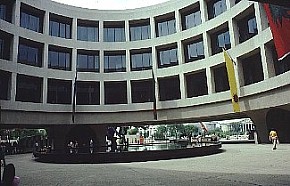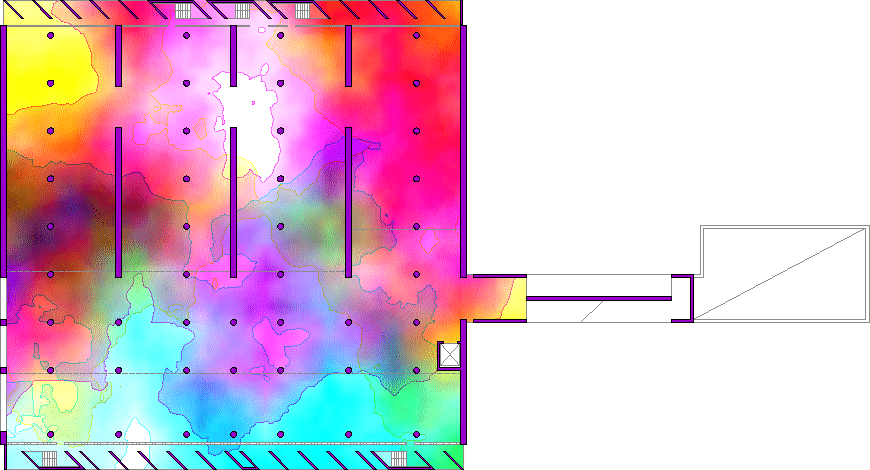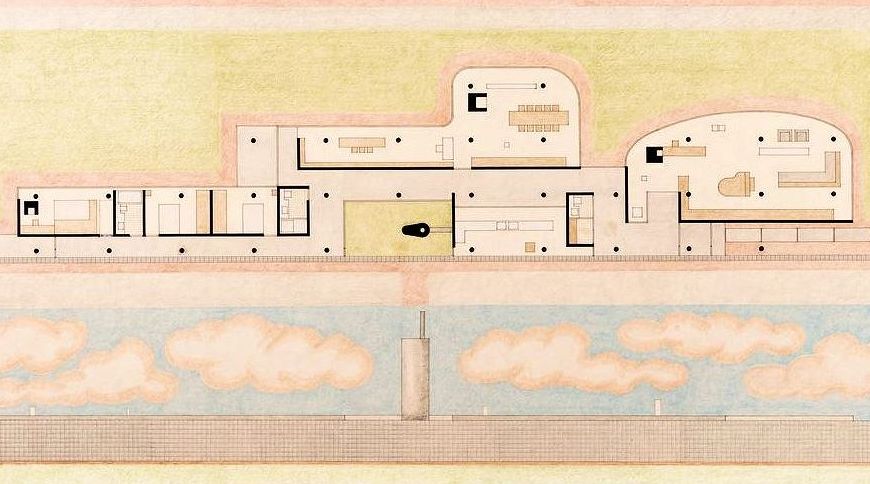2008.04.22 15:59
Happy Birthday Jim!
Between studies there were a good few parties at Yale: parties in the Rogerses' house when their old lady was away in Florida; parties in Eldred's attic, parties given by other students, and above all a big party given by Paul Rudolph for Jim, which has become legendary. Richard Rogers vividly remembers the crucial episode at it: 'He had this amazing modern, real extreme modern, slightly Hollywood apartment, with steps coming in at the higher level, marble steps cantilevered off the wall. At the end there was a double-height wall of glass, and outside this there was probably seven foot of open space before a big white wall. The wall had a great light on it so you looked at it as though it was the screen of a cinema, and the light reflected back into the room -- absolutely white. And everybody else was there. There was a piano, and let's say a hundred people. An hour later, still no Jim. No Eldred. Door opens up at high level, there's a commotion, yells and giggles and so on, and then suddenly there come Eldred and Jim, down these cantilevered slightly marbly steps, giggling because they're canned, literally just rolling down these goddamn steps, drunk. It was a great entry. Paralytic. And like a lot of these paralytic situations, they didn't hurt themselves. A few minutes later Jim says "Where's the loo?" Somebody says, "Oh, it's upstairs." Jim says, "Fuck the loo" or something, goes into the space outside, in front of this unbelievable white screen, turns round and pisses against the glass, with about a hundred people who could look nowhere else. Like on a cinema screen.'
This story is endlessly retold. It is the best known of the many stories about Jim. All the versions are a little different, not surprisingly, as everyone was well stocked up with drink when it occurred. It has been improved on -- it seems likely, for instance, that the people at the other end of the room remained unaware -- but it happened. Rudolph hated to talk about it. Other people have different theories about why Jim did it: Rudolph had flayed Jim at a crit, as was sometimes his way with critics as well as students, and this was Jim's way of getting back at him; it was a 'sod you' gesture against the Yale establishment; it was just because Jim was drunk and happy. Perhaps it was a bit of all three, perhaps mostly the last. Explanations vary, but the basic image remains: Jim, with a big grin on his face, peeing against the glass.
--Mark Girouard, Big Jim: The Life and Work of James Stirling (London: Chatto & Windus, 1998), pp. 124-5.
And did you know Pop Art died today 44 years ago?
2008.04.22 16:08
Sanskar Kendra

The Hirshhorn Museum in Washington DC appears to be a direct riff off Le Corbusier's museum paradigm. Reenactionary architecturism, if you will.
3333u
| |
2008.04.15 16:49
Floor Plans
Museum of Knowledge

3333u
Grandfather Wall House

5708c
| |
2020.01.12
notes
...do a Word export of The Sphere and the Labyrinth as well...
Introduction:
The Historical "Proiect"
There comes a moment (though not always) in research when all the pieces begin to fall into place, as in a jig-saw puzzle. But unlike the jigsaw puzzle, where all the pieces are near at hand and only one figure can be assembled (and thus the correctness of each move be determined immediately), in research only some of the pieces are available, and theoretically more than one figure can be made from them. In fact, there is always the risk of using, more or less consciously, the pieces of the jigsaw puzzle as blocks in a construction game. For this reason, the fact that everything falls into place is an ambiguous sign: either one is completely right or completely wrong. When wrong, we mistake for objective verification the selection and solicitation (more or less deliberate) of the evidence, which is forced to confirm the presuppositions (more or less explicit) of the research itself. The dog thinks it is biting the bone and is instead biting its own tail.1
In this way Carlo Ginzburg and Adriano Prosperi synthesize the labyrinthine path of historical analysis and the dangers with which it is
fraught, in one of the few recent volumes that have had the courage to describe, not the Olympian and definitive results of research, but rather its tortuous and complex iter. But why should we propose, at the beginning of a volume dedicated to the adventures of architectural language, the problem of the "jig-saw puzzles" characteristic of historical research? In the first place, we could answer that our intention is to follow an indirect path. Contrary to those who pose the theme of architectural writing-the term "language" should, it seems to us, be adopted only as a metaphor2--we shall present the theme of critical writing: is it not the function of
criticism to constitute the historical (and thus the real) specificity of artistic writings? Does not historical work possess a language that, entering perpetually into conflict with the multiple techniques of environmental formation, can function like litmus paper to verify the correctness of discourses on architecture?
Only in appearance, then, will we speak of something else. For how often, when probing what is on the fringes of a given problem, do we discover the most useful keys for dealing with the problem itself-particularly if it is as equivocal as the one that we are about to examine.
Let us further define our theme. Architecture, language, techniques, institutions, historical space: are we simply lining up on a wire stretched over a void a series of problems, each with its own intrinsic characteristics, or can we legitimately contest the "terms" used here to trace these problems back to an underlying or hidden structure, in which these words can find a common meaning on which to rest? It is no accident that we have reduced to "words" the density of historically stratified disciplines. Every time, in fact, that the critic's zeal causes his guilty conscience to erupt, constructing linear routes that force architecture to migrate into language, language into institutions, and institutions into the all-encompassing universality of history, one feels the need to ask how such a totally illegitimate
simplification could. gain currency.
After the persuasive demonstrations of the untranslatability of architecture into linguistic terms, after Saussure's discovery that language itself is a "system of differences," after the calling into question of the conspicuous features of institutions, historical space appears to dissolve, to disintegrate, to become a justification for disordered and elusive multiplicity, a space of domination. Is this not the final outcome reached by a good part of the "Lacanian left" or by an epistemology of pure registration? And after all, is not architectural writing (this phantasm that we now recognize as divided and multiplied into techniques incommunicable among one another) itself an institution, a signifying practice-an ensemble of signifying practices-a multiplicity of projects of domination?
Is it possible to make a history...
|